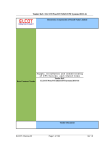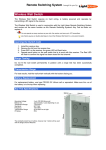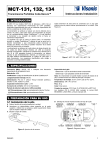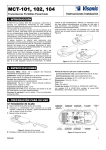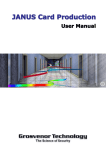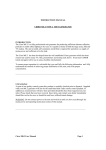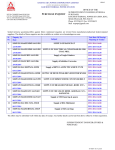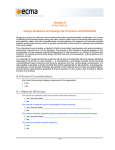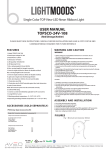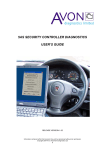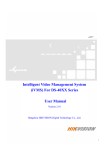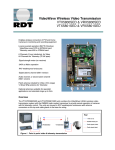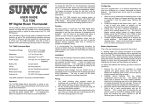Download Parsec Installation User Manual - Issue 9
Transcript
Newmark Technology Par-Sec RFID Asset Management UK Installation & User Manual Issue 9 – January 2005 CHANGE RECORD 1 2 3 4 5 6 Change No. ERN 11145 ECN 11154 ECN 11175 ECN 11176 ECN 11182 ECN 11193 Sep-97 Jan-98 Dec-98 Jul-99 Sep-99 Aug-00 7 ECN 11197 Jun-01 8 ECN 11200 Nov-03 9 N/A Jan-05 Issue Date Comments First release CAT replaced by RAT New PCB switch/links 4 and new section 5 added FCC statements added. Correction of Contents Page 3, Page 11 (fig. 3) A5 re-write & new format. All sections Major re-write due to UL approval changes. Range setting re-written. Sections 2.2, 4.2 & 9. Figs 2, 3 & 4 F.A.Q's added. Version 6 Firmware release, Master/Slave Reader, Dual Wiegand and ASCII text outputs Re-Layout of Reader PCB. Old type tag data removed from manual (tag transmission times) Newmark Technology Ltd Millars Three Southmill Road Bishop’s Stortford Hertfordshire CM23 3DH United Kingdom Tel: +44(0) 1279 658000 Fax: +44(0) 1279 504776 Web: www.par-sec.biz Web: www.newmarktechnology.com Document No: A/IM 230 800-2005 © 2003 by Newmark Technology Ltd The information in this document is subject to change without notice and should not be construed as a commitment by Newmark Technology Limited. Newmark Technology assumes no responsibility for errors that may appear in this document. No part of this publication may be transmitted or reproduced in any form by any means, without written permission from Newmark Technology Limited. Par-Sec Installation and User Manual Issue 9 – January 2005 Page 2 of 39 Contents Introduction.......................................................................................................................... 6 FCC Statement ............................................................................................................. 6 CE Compliance ............................................................................................................. 6 UL Listing ...................................................................................................................... 6 Text Conventions .......................................................................................................... 7 Chapter 1 - Product Overview ............................................................................................. 8 Chapter 2 - Version 6.0 Reader Firmware – New Features ................................................. 9 Master and Slave Reader Configuration ....................................................................... 9 Dual-Wiegand Messages (Reader Part Number PSRW26-26/1) ................................ 10 Tag Battery-Low Audio Visual Indication..................................................................... 10 ASCII Text Output ....................................................................................................... 10 Site Survey Mode........................................................................................................ 11 Relay Activation Time ................................................................................................. 11 Static Tag False Alarm Filtering .................................................................................. 11 Reader Address and Sub-Modes ................................................................................ 11 Chapter 3 - Static Tagging Applications............................................................................. 12 Introduction ................................................................................................................. 12 Typical Applications .................................................................................................... 12 Static Tagging Components ........................................................................................ 12 Static Asset Tag .......................................................................................................... 12 Long Range Asset Tag Reader................................................................................... 12 Static Application - Reader Location ........................................................................... 13 Static Asset - Site Survey Method ............................................................................... 14 Static Tag – Tamper Survey........................................................................................ 15 Reader Restrictions for Static Tagging Applications.................................................... 15 Chapter 4 - Portable and Personnel Tag Applications ....................................................... 16 Introduction ................................................................................................................. 16 Typical Applications .................................................................................................... 16 Portable and Personnel Tagging Components............................................................ 17 Personnel Tag............................................................................................................. 17 Portable and Personnel Tagging – Reader Location ................................................... 17 Portable Asset & Personnel Tracking - Site Survey Method........................................ 18 Portable Tag Reader Adjustment ................................................................................ 18 Portable Tag – Tamper Survey ................................................................................... 20 Reader Restrictions for Portable Tagging Applications ............................................... 20 Par-Sec Installation and User Manual Issue 9 – January 2005 Page 3 of 39 Chapter 5 - Par-Sec Tags.................................................................................................. 21 Types of Par-Sec Tag ................................................................................................. 21 Static Asset Tag Sensitivity ......................................................................................... 22 Routine Tag Reporting ................................................................................................ 22 Affixing Asset Tags ..................................................................................................... 23 Surface Preparation .................................................................................................... 23 Tag Bonding Time....................................................................................................... 23 Asset Tag Removal..................................................................................................... 24 Tag Transmission Times (Current Tag Types) ............................................................ 26 Chapter 6 - Installing a Par-Sec Reader ............................................................................ 27 Installation................................................................................................................... 27 Installing the reader..................................................................................................... 28 RS-232 Wiring............................................................................................................. 29 RS-232 Baud Rate ...................................................................................................... 29 Wiegand Wiring........................................................................................................... 29 Wiegand Connections to Commonly Used Access Control Panels ............................. 30 Newmark Technology – C.Cure Access with QPINT Interface: ................................... 30 Grosvenor Technology – JANUS Intelligent Door Controller (IDC):............................. 30 Chapter 7 - Commissioning a Par-Sec Reader.................................................................. 31 Reader Switch Settings............................................................................................... 31 Figure 7.1 Reader Layout ........................................................................................... 32 Reader - Physical Layout of Switches ......................................................................... 32 Functional Checks....................................................................................................... 32 Portable Tag Range Adjustment (PAT & PET)............................................................ 32 Static Tag Range ........................................................................................................ 32 Reader Range Checks................................................................................................ 33 Reader-Cover (Lid) Tamper ........................................................................................ 33 Reader Address Programming (RS232 only) .............................................................. 33 Alarm Relay Time........................................................................................................ 33 Chapter 8 - Trouble Shooting and Maintenance ................................................................ 34 Montag ........................................................................................................................ 34 Reader Reset.............................................................................................................. 34 No Response when Tags are Activated ...................................................................... 34 FAQ’s.......................................................................................................................... 34 Reader and System Check. ........................................................................................ 35 Tag Check................................................................................................................... 35 Par-Sec Installation and User Manual Issue 9 – January 2005 Page 4 of 39 Appendix A ........................................................................................................................ 36 Technical Support ....................................................................................................... 36 Appendix B ........................................................................................................................ 37 Equipment Specifications ............................................................................................ 37 Reader Range............................................................................................................. 37 Product Dimensions .................................................................................................... 37 Environmental Temperatures ...................................................................................... 38 Electrical Power Supply .............................................................................................. 38 Reader Data Outputs .................................................................................................. 38 Radio Transmissions................................................................................................... 38 Alarm Relay ................................................................................................................ 38 External LED Inputs .................................................................................................... 39 Certification & Approvals (Dependent upon item)........................................................ 39 Par-Sec Installation and User Manual Issue 9 – January 2005 Page 5 of 39 Introduction FCC Statement Some of these devices comply with part 15 of the FCC CFR 47 rules. Operation is subject to the following two conditions: These devices may not cause harmful interference and, These devices must accept interference received, including interference that may cause undesired operation. The user is cautioned that modifications or changes to an intentional or unintentional radiator not expressly approved by the party responsible for compliance could void the user's authority to operate the equipment. CE Compliance The reader has been tested and found to comply with the emission limits for access control devices as described in EN 50081-1: 1992, and immunity to EN 50082-1: 1992. These limits are designed to provide protection from harmful interference when the unit is operating in a commercial or residential environment. This equipment generates, uses, and can radiate radio frequency energy. If the unit is not installed and used as instructed in this manual, it may cause interference to radio communications. Properly grounded and shielded cabling should be used for all incoming and outgoing connections to the reader and peripheral equipment. UL Listing Reader’s and tag’s, where indicated, are UL listed. UL294-access control unit accessory and UL1037 - also suitable as an anti-theft device. To maintain listing, the reader shall be connected to UL Listed equipment. Par-Sec Installation and User Manual Issue 9 – January 2005 Page 6 of 39 Text Conventions This manual uses the following symbols as shown: Format or Symbol NOTE Meaning A technical note or explanation. A technical tip, which may help you to perform a certain task or operation with greater efficiency. TIP A note that may have special importance. Indicates a cautionary note and contains essential information. "CAUTION" Asset tags contain lithium batteries. ASSET tag’s (PAT and SAT) contain batteries, which cannot be replaced or recharged! The WHOLE tag must be disposed of in the correct manor, and not discarded in normal office rubbish/trash. Contact your local authority for advice and information on the correct method for lithium battery disposal. The batteries used in this device may present a risk of fire or chemical burn if mistreated. Keep away from children. Do not recharge, disassemble, heat above 100deg. C (212deg. F), or incinerate. Replace battery in the personnel tag’s type PET with VARTA type CR2430 or equivalent. Use of another battery may present a risk of fire or explosion. To maintain UL listing, Par-Sec readers must only be connected to a UL listed 12Vdc burglar alarm power supply Some devices used within the Par-Sec reader are sensitive to static electricity. Anti-static precautions must be taken at all times when handling the printed circuit boards. Static discharge may permanently damage the circuit boards. Damage may not be immediate, but may affect the life of the circuit board. Par-Sec Installation and User Manual Issue 9 – January 2005 Page 7 of 39 Chapter 1 - Product Overview A basic asset tagging system comprises of a long-range receiver (reader) which is used to detect radio transmitters (tags) carried by people or attached to moving or stationary assets. The system works upon tag motion or tamper events being detected within a pre-defined reception area or zone. The tag event is reported to a host system where the event is processed and actions or alarms may be initiated. Typical applications for this product are: Protection of valuable static items such as IT equipment, network servers or items in galleries and museums Control and tracking of portable, high value assets such as laptop computers and electrical equipment Long range, hands free, perimeter access control at vehicular barriers. Personnel tracking as an aid to health & safety monitoring The reader detection range is up to 30Mtrs (100’) dependent upon the type of tag, the event and the RF environment, it can be adjusted between 1–18Mtrs. (3’–60’) when using Portable or Personnel tags. It is important to understand at this initial stage that the reader range adjustment is not an exact science and that local environmental conditions will always have an effect on the equipment’s performance. Reading distances stated throughout this manual are approximate and are the typical read-ranges in open air. The static tag range is not adjustable and is permanently fixed at maximum which is up to 30Mtrs. (100’). Par-Sec readers have a choice of two data outputs, RS232 and 26bit Wiegand. The RS232 option is designed for use with the DDE (Data Display and Entry Panel) or other third party asset management software. Typically, with the DDE, a chain of up to nine readers can be coupled together to protect a single large area or number of individual areas within a building. For more information see the DDE user manual or contact Newmark Technology. The Wiegand output option is designed for use with third party access panels and software that has a 26bit Wiegand reader interface. The reader has a single relay output that activates upon a tag motion or tamper detection and can be used to trigger alarms when connected to an intruder panel. Asset tags in motion transmit a unique identification number accompanied with a “MOTION” status report. Asset tags also have a built-in tamper switch which when activated initiates and transmits a tag “TAMPER” report. Par-Sec tags transmit at 418MHz using very low power levels, which in the UK is MPT1340 license exempt by the DTI. Tags and readers are CE approved and comply with the European EMC directives. Some are also UL294 and UL1037 approved (Access control and burglar alarm system accessories). Par-Sec Installation and User Manual Issue 9 – January 2005 Page 8 of 39 Chapter 2 - Version 6.0 Reader Firmware – New Features Version 6.0 reader firmware offers a new generic reader type (PSRW26-232/1) supporting both Wiegand and RS232 data outputs which are switch selectable via switch S2. S2 position 0 = Wiegand data output. S2 position 1-9 = RS232 + reader address. Firmware version 6.0 also facilitates a new reader arrangement referred to as the Master and Slave reader configuration. Master and Slave Reader Configuration A Master Wiegand reader can receive incoming tag data on its RS232 port as well as the RF channel. Data received via the binary input and the RF receiver is reported in Wiegand format. A Master Wiegand reader can connect up to 3 Slave RS232 readers to form a reader chain. A chain of readers can connect to the single reader port of an access control system and appear as a single, enlarged reader zone on the system. This feature can be used to provide either a zone of readers for static tag detection or as a dual reader configuration protecting entrances/exits for portable asset tag detection. Figure 2.1 Master & Slave reader configuration for portable tag detection Master & Slave Readers Configured for Tamper Coverage (PAT Tags) Slave Readers (RS232) Master Reader (26bit Wiegand) Access Controller Reader 1 Reader 2 Master Reader (26bit Wiegand) Slave Reader (RS232) Master & Slave Readers in Entry/Exit Configuration (PAT Tags) Par-Sec Installation and User Manual Issue 9 – January 2005 Page 9 of 39 Figure 2.2 Master/Slave reader configuration for static tag detection Master & Slave Readers Configured for Tamper Coverage (SAT Tags) Slave Readers (RS232) Master Reader (26bit Wiegand) Access Controller Reader 1 Reader 2 Slave Readers (RS232) Master Reader (26bit Wiegand) As well as the Master and Slave configuration version 6.0 firmware also supports the following features: Dual-Wiegand Messages (Reader Part Number PSRW26-26/1) Readers using a Dual-Wiegand mode support a Dual-Wiegand message. The unique ID number of a tag is reported when a Tag-Tamper or Tag-Low-Battery is detected. Previously users were only presented with the tag’s site code and the unique ID and could not distinguish between tag-motion, tag-tamper or low battery event. By associating the additional reader information with the tag ID in your own software, you can provide additional tag status information to the system user. The two default tag messages are reported immediately after a Tag ID report, therefore associating the status message with the specific tag. For further information on how to implement and use the Dual Wiegand message in your own software contact Newmark Technology. Tag Battery-Low Audio Visual Indication Readers provide an audio-visual indication when a tag is detected in the Low Battery State. The reader emits a short burst of audible beeps and the left-hand RED LED flashes on the detection of a low-battery tag event. ASCII Text Output Readers set to Wiegand mode support ASCII text reporting from their binary RS232 port. The reader reports tag ID and status as well as the tag routine reports and reader-cover tamper events. This feature can be used as an installation and commissioning aid when initially setting up an asset tagging system. The text output can be connected directly to a standard serial printer or a PC running HyperTerminal. The text output feature can also be utilised to provide a log of tag activity and for checking the system integrity. Par-Sec Installation and User Manual Issue 9 – January 2005 Page 10 of 39 Site Survey Mode Used only for reader set-up and commissioning. This feature provides the user with real time tag events rather than the 1 per 5 second normal tag report rate and makes reader range adjustment and site surveying faster and easier. Site survey mode = Switch S9 position 7 Relay Activation Time Par-Sec readers are fitted with a selectable relay time activation switch. Readers now have 10 pre-defined relay activation times from zero to 120 seconds. Relay Time = Switch S12 positions 0-9 Static Tag False Alarm Filtering This feature was previously referred to as “pulse count” on earlier readers. Par-Sec version 6.0 readers now have 3 pre-defined filters for static tag motion events which are 6, 12 and 18 second time intervals, where static tags transmit motion but are not reported by the reader. This feature is designed to reduce the amount of false alarms such as those caused by inadvertent static asset tag movement. Reader Address and Sub-Modes Par-Sec readers now support both RS232 and Wiegand data outputs along with a selection of sub-modes. These modes allow the selection of two Wiegand output rates of 4 and 8 messages per second and the ability to select the battery low audio-visual indication and tag loitering reports. These new features are selectable via switch S3. Par-Sec Installation and User Manual Issue 9 – January 2005 Page 11 of 39 Chapter 3 - Static Tagging Applications Introduction Static asset tagging performs a number of functions. It identifies individual assets, their whereabouts and detects and reports attempted theft or vandalism. A typical system may consist of static asset tags affixed directly or indirectly to static assets or artefacts. The artefacts would be monitored by one or more long-range readers strategically positioned in a designated protection area. The tag transmits its ID number and status if moved or tampered with and the readers report the information to a stand-alone or on-line security system. Data from the Par-Sec reader can be associated with the artefact and activate any number of system events. Such events can be treated in a number of ways, from event logging only to triggering pre-set positions on a CTTV system or simply sounding a local siren and sending security staff to investigate. Alternatively, readers can be connected directly to an intruder panel using the reader’s relay contact. This simple solution can be used to dial-up a central monitoring station or sound local alarms when a tag event is detected. Typical Applications Museums and art galleries, protecting paintings, display cabinets and high value artefacts such as statues, sculptures, textiles and pottery Schools and universities, protecting network servers Commercial businesses and institutions, protecting fixed assets, network servers, IT equipment, laboratory equipment etc. Asset tagging can also be applied to warehousing applications and car dealerships/parking lots, or for the protection of any type of high value short term or long term inventory. Static Tagging Components A typical static asset protection system consists of two main pieces of equipment: Static Asset Tag The asset tag is an RFID transmission device that has its own unique ID consisting of a site code and tag number. The tag will transmit its data immediately upon the following stimulus: Motion, (multiple pulses in 5 seconds) Tamper, (multiple pulses in 5 seconds) Routine Report, (1 report per hour, optional) Low Battery State (attached to each of the above events) Long Range Asset Tag Reader The reader is a long-range RF receiver with a fixed reception range for static assets tags. The range is dependant on background interference and the local RF environment. This range could be up to 30Mtrs. (100ft) radius. The reader responds to tag messages in a number of ways: Activates internal LED’s and sounder Triggers an internal relay contact Reports the tag ID number and tag status data in RS232, Wiegand format (Typically 26bit) or ASCII text format. Par-Sec Installation and User Manual Issue 9 – January 2005 Page 12 of 39 Static Application - Reader Location The physical location chosen to site each reader will depend principally upon the following: Figure 3.1 Typical reader location for static tagging applications The detection area required for static asset tags (SAT) for both motion and tamper events The building physical layout, structure and internal décor Cabling routes and the distance between each reader Cabling distances between readers and intruder or access panels Environmental conditions. (See location and restrictions notes) Static Tag Reader S t Static Tag (SAT) Where a system is employed to monitor the unauthorised movement of static items, the reader should be mounted as high as possible to maintain the best line of sight between the reader and tag. Ideally readers should be positioned centrally on the wall to provide the best possible reception and coverage. Where suspended ceilings are constructed from metal frames or tiles, readers should be mounted at least 0.5m (1’-2') below the ceiling level. Par-Sec Installation and User Manual Issue 9 – January 2005 Page 13 of 39 Where large irregular areas require coverage a number of readers can be connected together to produce a reader zone. For further details see the section on Master and Slave reader configuration. Multiple Readers wired together on a chain protecting an irregular area Figure 3.2 Protecting an irregular area using multiple readers M u M i p l Static Asset - Site Survey Method It’s always a good idea to temporally mount the reader when performing a site survey. You may need to move the reader from one location to another to achieve the best results. It is important that the surroundings are close to the normal working environment in which the tagging system is intended to work. Results gained from a site survey conducted in an empty office space cannot be relied upon once the office has been occupied with staff and equipment. NOTE: 1) A tag attached to an asset will produce a different range of characteristics to that of a tag held in free space. Therefore, it is very important that you have an exact example of the asset you wish to protect while performing your site survey. If a number of different types of asset are being tagged, the reader must be tested with all of them. Power up the reader with a 12Vdc supply Set rotary switch S9 to position 7- SITE SURVEY MODE. The reader will report tag detection once every 0.7 seconds in this mode, providing ‘real time’ tag events Press switch S15 (master reset) to invoke the site survey mode Position the reader in a prominent location, preferably as high as possible and ensuring you or a colleague are able see and hear the reader’s audio-visual indications Power-on a static asset tag, (Switch 1). Affix the tag to the intended asset TEMPORARILY, so that the tamper switch is depressed. A suitable tape or non-metallic clamp may be used to affix the tag at this time If attaching a tag to the asset is not permissible, then simply hold the tag with the tamper switch depressed in very close proximity to the asset. Make sure the tag is held between the thumb and forefinger and at arms length, so that your physical presence does not shield the tag in any way Par-Sec Installation and User Manual Issue 9 – January 2005 Page 14 of 39 Gently agitate the tag and check that the green LED on the reader flashes at a steady rate (approx. one flash per second) With the reader in position, move around the area continuously agitating the tag. Check that tag transmissions can be read from every conceivable location. Keep moving away from the reader until the tag is no-longer read or until you continue to be read at the extremities of the area being surveyed If you loose reception at any time or in any particular location you must be sure to mark this area clearly on your plans as a potential blind spot in which case, additional readers may be required If additional readers are required, always ensure that the reception range from the readers overlap, so that in certain locations more than one reader can report the tag at one time Continue to survey the site until the whole area is covered by reader reception. Static Tag – Tamper Survey With the reader/s positioned about the intended protection area, walk around the area setting off a tag in tamper mode. Check to see that the tamper transmissions are read from every conceivable location. If you find potential blind spots, readers may need relocating or additional readers may be required to obtain the tamper coverage required. Reader Restrictions for Static Tagging Applications Reader reception is at its best directly in front of the reader. Therefore, the reader should be oriented front facing forwards for the best performance Although the reader’s reception area is roughly spherical, the reader will have a reduced reception range at the rear and sides Due to RF reflections and shielding, the presence of steel girders, metal furniture, false ceiling supports and aluminium backed plasterboard can all produce good and poor reception areas. It is impossible to visualise these influences but will become apparent during a survey. If they occur, it may be necessary to re-position a reader or include additional readers The standard reader is designed for indoor use only and is not weatherresistant. If a reader is to be mounted outside it must be housed in an allplastic, suitably rated weather resistant enclosure, ideally IP65 or higher. It is good practice to place a non-metallic rain shield above the reader to prevent standing water resting on the reader enclosure itself The presence of water in any form will have a detrimental effect on tag reception range Never mount readers inside metal enclosures or directly onto metal surfaces. Par-Sec Installation and User Manual Issue 9 – January 2005 Page 15 of 39 Chapter 4 - Portable and Personnel Tag Applications Introduction A typical system for portable asset detection will consist of portable asset tags (PAT) affixed directly to portable assets. The reader range is adjusted to form a detection zone, for example at an entry/exit point. The portable asset can move freely about the office without being detected by the reader. Only when a portable tag is detected within the reader pre-set range will it be reported. Tamper events however, are detected up to 30Mtrs. (100’) from the reader and can not be adjusted. The tamper area can be further extended by installing additional readers. When setting up a portal protection range it must be understood that in some installations, unwanted events may occur due to the office layout and the close proximity of tags to the protected entry/exit points. In these circumstances, access control and CCTV systems can provide further information of tag events, door events and personnel movement. With the readers set to their maximum range they can be used to detect portable and personnel tags over a wider area to cover rooms and corridors, providing real-time asset and personnel tracking features. Readers can be interfaced to an access panel using the Wiegand output, but rather than being associated as access events, the readers are used to create supervised/monitored zones with real time reporting of tag events from within the zones. Data from the Par-Sec reader can be associated with the artefact or person and activate any number of system events. Such events can be treated in a number of ways, from event logging only to triggering pre-set positions on a CTTV system, sounding local alarms and graphically tracking personnel on the system. Alternatively, readers can be connected directly to an intruder panel using the reader’s relay contact. This simple solution can be used to dial-up a central monitoring station or sound local alarms when a tag event is detected. Typical Applications Businesses and institutions, protecting portable assets, laptop/desktop computers, network servers, IT equipment, laboratory equipment etc. Asset tagging can also be applied to warehousing applications and car dealerships/parking lots, or for the protection of any type of high value, short term or long term inventory Tracking of personnel around large areas Perimeter access for vehicles and personnel Par-Sec Installation and User Manual Issue 9 – January 2005 Page 16 of 39 Portable and Personnel Tagging Components A typical portable and personnel tagging system consists of two main pieces of equipment. Depending upon the system type it will have either a Portable Asset Tag or a Personnel Tag and a Reader: Portable Asset Tag The Portable Asset Tag is an RFID transmission device, which has its own unique ID, consisting of a site code and tag number. The tag will transmit its data immediately on the following events. Motion, (multiple pulses in 5 seconds) Tamper, (multiple pulses in 5 seconds) Routine Report, (1 report per hour, optional) Low Battery State (attached to each of the above events) Personnel Tag The Personnel Tag is an RFID transmission device, which has its own unique ID, consisting of a site code and tag number and transmits its data every 0.7 seconds. Long Range Asset Tag Reader Firstly, the reader is a long range RF receiver for tag-tamper events. The tamper range is permanently fixed at maximum which dependant upon background interference and the local RF environment, could be up to 30Mtrs. (100’) radius. A second reader channel can crudely be adjusted to detect portable tag motion events and/or personnel tag events. This range can be adjusted between 0-18Mtrs. (0-60’) dependent upon the local RF environment. The reader responds to tag massages in a number of ways: Activates an internal LED and sounder Triggers an internal relay contact Reports the tag ID data in RS232 or Wiegand format (typically 26bit). Portable and Personnel Tagging – Reader Location The physical location chosen to site each reader will depend principally upon the following: The exit/entry point locations and general layout within an installation Environmental conditions. (See location and restrictions notes) The area of coverage required for portable and/or personnel tracking The area of coverage required for portable tag tamper events The installation for portable asset tags consists of readers dedicated to two separate tasks: Perimeter readers positioned at high level to cover the entire office area for tag tamper and battery-low events Master/Slave readers, positioned to the left and right side of every portal to provide detection zones for portable tags in motion. Readers should be positioned approx. 1.2Mtrs. (4’) from the floor for the best results The installation for personnel tracking consist of readers suitably positioned to cover the areas or zones to be monitored and positioned at a high level to cover the maximum area. Par-Sec Installation and User Manual Issue 9 – January 2005 Page 17 of 39 Figure 4.1 Portal protection with Master/Slave reader configuration. When readers are deployed as tag-tamper monitoring zones only, the short reading range on these readers should be adjusted to zero. This is to prevent false alarms/events when the portable tags move legitimately about the area and pass in close proximity to the tamper readers. Where large irregular areas need to be protected for asset tag tamper a number of slave, RS232 readers can be connected to a single master reader. The maximum number of slave readers on a master/slave chain is restricted to 3. Portable Asset & Personnel Tracking - Site Survey Method This part of the manual should be read carefully and understood before installing any Par-Sec system. This section provides an insight into the reader performance and its characteristics. It also includes information about fine tuning of the reader range. It is best practice to mount the reader temporally when performing a site survey as you may need to move the readers to achieve the best results. NOTE: 1) A tag attached to its asset will produce different range characteristics to that of a tag held in free space. Therefore it is important that you have an example of every asset you wish to protect whilst performing a site survey. Metallic assets will have an effect on tags and may reduce the PAT range by up to 75%. This includes all computers and laptops. Portable Tag Reader Adjustment Reader range adjustment is achieved by adjusting the signal strength threshold of the receiver circuit. This is performed by setting the reader into a scanning mode and by using the +ve an -ve buttons on the range adjustment tool (RAT) to increase or decrease the threshold level. This threshold can be visualised by connecting a digital voltmeter across pins 1 and 5 on PL2 (LH side of the top PCB) where you will observe a voltage between 0-5Vdc. The voltage will increase/decrease in increments of 50mV with every press of the RAT + and – buttons. Par-Sec Installation and User Manual Issue 9 – January 2005 Page 18 of 39 The reader has four switches, which may be used to increase the gain of the receiver and provide greater range. Connect the DVM to the top and bottom pins of the Molex header (PL2) on the left hand side of the Logic PCB Power up the reader. You will notice that a voltage reading between 0 & 5V will appear on the DVM. Zero volts represents minimum and 5V corresponds to maximum range Switch on your tag (Switch 1) and affix it to the intended asset TEMPORARILY, so that the tamper switch is depressed. A suitable tape or non-metallic clamp may be used to affix the tag Press the Scan Reset button (S6) - the red power LED will flash. The reader is now in range adjustment mode and will respond to any RAT commands. If the pre-set range of the reader is close to the range you require, you can use the + & buttons to make minor adjustments. If the range needs to be reset then use the FIND button as follows. Position yourself in front of the reader where you would like tags to be read, hold the RAT in a vertical plane so that the rear of the case is facing the reader, press and hold down the FIND button. You will notice that the left hand side RED LED will flash repeatedly and within a short time the reader will "find" the RAT and set the range at your location. This will be signified by a tone sounder (single "beep") at the reader. The sounder will continue to beep and the left hand LED will flash as long as you hold down the FIND button, but you will notice that the voltage will remain locked. To unlock the voltage, press the + or - button momentarily. You can do a very rough assessment of the range by pressing and holding the SEE button on the RAT. When the reader sees the RAT it will again operate the tone sounder. Check that the range is correct by attaching a PAT tag to a typical asset. Because the RAT is physically different from an asset tag and the fact that it is not attached to an asset means it can only be used to set an approximate range. You will need to fine tune the range to accommodate your tagged asset. Activate the PAT motion sensor by walking slowly towards the reader. The amber LED & tone sounder will operate on the reader when the tag is read. This indication will occur every 5 seconds whilst the PAT remains within range (for RS232 readers). For best results repeat this test several times as well as approaching the reader from different directions. This will highlight both good and poor reception areas. Remember that if you set the range too long you will get false alarms from tagged assets or PET’s in adjacent areas. In all except very large open areas or outdoors, you will find blind spots and hot spots. This is caused by radio signals from the tag being reflected from walls, ceilings, furniture and people. For a range of about 2Mtrs. (6') for a PAT on a laptop or a PET worn close to the body, the voltage on the DVM should be about 4.0V. For a range of about 2m for a PAT on a nonmetallic surface e.g. a painting, the voltage on the DVM will be about 2.5V. Remember that portable asset tags mounted on or near a metallic surface e.g. laptop PC's, will have a range of only about 1/3rd of that in free space. Personnel tags will also have less range when worn close to the body. These figures are for reference only and may not suit your specific application. If you are not satisfied with the range setting make minor adjustments using the RAT + & buttons. Press the keys momentarily and check that the left hand RED LED on the reader flashes with each RAT command. Very brief presses of less than 0.3 seconds will be ignored. It is well worth taking a little extra time and effort to check that the range and reading area are satisfactory at this stage. Note that the voltage on the DVM moves up or down by about 50mV for each press of the RAT + or – button. Par-Sec Installation and User Manual Issue 9 – January 2005 Page 19 of 39 Once you are satisfied with the reading range, press and release switch S6 on the logic PCB, this will store the range adjustment in the reader memory. The right hand RED LED will stop flashing signifying the reader is out of range adjustment mode. The range setting is stored in non-volatile memory, so it will be retained even if the reader power is disconnected. In certain installations it may not be possible to obtain an adequate long range for PET's or PAT's in motion. Typically this may be in areas of high radio interference. In these situations try increasing the receiver gain by turning ON individual poles of switch S5. Firstly start with S5-1 ON (this will double the gain). If required use the other poles of S5 to achieve the required range. Repeat the range setting procedure using the RAT. If at any time you wish to alter the range, repeat the above procedure as many times as required. NOTE: 1) The gain switch settings are denoted as a multiplication of 2, 4, 8 and 16 times the normal gain. This is only gain amplification and is not directly related to range. Therefore x 16 may not produce 16 times the reader range. The gain switches also have no effect on the SAT and PAT range in TAMPER. Portable Tag – Tamper Survey With the reader/s positioned about the intended protection area, walk around the area setting off a tag in tamper mode. Check to see that the tamper transmissions are read from every conceivable location. If you find potential blind spots, readers may need relocating or additional readers may be required to obtain the tamper coverage required. If you wish to use the reader only for long range tamper of PAT tags, you can inhibit the reception of PAT's in motion and PET's by setting the reader range voltage to ZERO volts. This will prevent PAT's in motion and PET's from being read. Reader Restrictions for Portable Tagging Applications Reader reception is at its best directly in front of the reader. Therefore the reader should be oriented front facing forwards for the best performance Although the reader’s reception area is roughly spherical, the reader will have a reduced reception range at the rear and sides Due to RF reflections and shielding, the presence of steel girders, metal furniture, false ceiling supports and aluminium backed plasterboard can all produce good and poor areas of reception. It is impossible to visualise these influences but will become apparent during a survey. If they occur, it may be necessary to re-position a reader or include additional readers The standard reader is designed for indoor use only and is not weatherresistant. If a reader is to be mounted outside it must be housed in an allplastic, suitably rated weather resistant enclosure, ideally IP65 or higher. It is good practice to place a non-metallic rain shield above the reader to prevent standing water resting on the reader enclosure itself The presence of water in any form will have a detrimental effect on tag reception range Never mount readers inside metal enclosures or directly on metal surfaces. Par-Sec Installation and User Manual Issue 9 – January 2005 Page 20 of 39 Chapter 5 - Par-Sec Tags Types of Par-Sec Tag There are three types of Par-Sec tag. The Static Asset Tag and the Portable Asset Tag look identical and share the same internal electronics. Both tags have a motion sensor, tamper switch and are powered by lithium coin cells, which are non-replaceable. The third type of tag, the Personnel Tag, is described at the end of this section. The Current Versions of Asset Tags are: PSSAT/2 (Previously known as PSSAT-2) – Transmits 7 pulses every 0.7 seconds every activation. Transmits 7 tamper transmissions only. PSPAT/2 (Previously known as PSPAT-2) – Transmits 7 pulses every activation. Transmits 7 tamper pulses only, until the tamper switch is depressed for 5 sec. then released again. Previous Versions of Asset Tag are: PSSAT1/1 – UK static asset tag transmits 4 pulses at 0.7 sec. intervals at high power every activation. Constant tamper transmission. PSSATS/1 (Previously known as PSSAT-S) – Transmits as PSSAT/2, but has a very sensitive motion sensor. PSPAT1/1 – Early UK portable asset tag, transmits 4 pulses, every 0.75sec. for 3 minutes when activated. Transmits tamper every 0.7sec. continuously until the tamper switch is depressed. PSPAT2/1 (Previously known as PSPAT1-2) – Same as PSPAT/2 but with higher transmission power for UK market. Fitted with more sensitive motion sensor than the earlier UK version. Transmits 7 pulses every activation. Transmits 7 tamper pulses only, until the tamper switch is depressed for 5 sec. then released again. Always remember that mounting asset tags on or near a metallic surface will result in up to 75% loss in range. The thickness of the self-adhesive pad supplied with the tags is designed to leave an air gap underneath the tag. Reducing this gap to zero on a metal surface may inhibit the tag transmission. These tags should always be located horizontally or vertically as near to a corner of the asset as possible with the arrow on the tag pointing towards an outside edge of the asset. The arrow printed on the tag's top face points to the antenna which needs to be in as much free space as possible. Figure 5.1 Tag location and orientation Tag Asset 2 3 Or Asset Par-Sec Installation and User Manual Issue 9 – January 2005 Page 21 of 39 3 2 Tag Although laptop computers have a plastic outer case, there is always a metal screen behind the display. You may have to test several positions with the tag before you find the optimum situation. We recommend that you always temporarily fit a tag to an asset if it contains metal and check that the range is adequate before fixing it permanently. Once you have found the best position for the tag on the asset, you will be able to fit subsequent tags in the same position for similar models. Remember to ensure that the tamper switch spring is pushed in when doing these tests. The tamper alarm always operates at high power at long range. Note: some laptop docking stations may not allow the use of an asset tag. Check that the laptop can be used in its docking station with a tag attached before installing the system. Static Asset Tag Sensitivity When using the older type UK SAT tags PSSAT1/1, the SAT tag sensitivity at the reader can be adjusted by changing the setting on switch S9 on the reader logic-PCB. See your previous Par-Sec manual or contact Newmark Technology for further information. S9 can also be used with the pulse count facility on the DDE panel when using both UK & FCC type SAT tags. Refer to the DDE manual for further details In normal circumstances switch S9 should be set to position 1. NOTE: 1) Positions 8, 9 & 0 of S9 should not be used. Routine Tag Reporting If you switch on position 4 on a SAT or PAT tag prior to turning the tag on it will activate the tag routine report function. About every hour the tag will automatically transmit its data and status. This occurs even if the tag motion sensor or tamper alarm is not activated. In some applications this could be used to indicate that an asset has not been moved out of range or that the battery has expired. It is a positive signal that the tag is still in range and transmitting. If the tag is moved or the tamper alarm is activated then the next routine report will be 1 hour later. If you wish to disable the routine report you will have to remove the tag from the asset, turn off switches 1 & 4 and then turn switch 1 on again. Hourly routine presence reports are only supported on asset tags. Figure 5.2 Asset tag switches Tamper Switch ON 1234 Switch 1 Asset Tag power On/Off Switch 2/3 Reserved for future use, do not use Switch 4 Hourly Routine Report On/Off (Must be powered-on prior to switching tag on) Par-Sec Installation and User Manual Issue 9 – January 2005 Page 22 of 39 Affixing Asset Tags Every asset tag is shipped with a double sided adhesive pad specifically selected for this application. The thickness of the pad and the length of the tamper switch spring have been designed to provide the best results. Any change to the mounting methods or adhesives must first be approved by Newmark Technology. The critical factors that are of concern when fitting a tag to an asset are: Surface preparation Adhesive bonding time. Surface Preparation To obtain optimum tag adhesion, the bonding surfaces must be clean, dry and well unified. Typical surface cleaning solvents are isopropyl alcohol/water mixture. Be sure to follow the manufacturer’s directions and precautionary warnings when using solvents and always spot-test before applying to a new surface. Figure 5.3 Surface preparation Step A: Clean Step B: Wipe Dry Figure 5.4 Affix tag to asset Step C: Fit Tag Step D: Apply Pressure Tag Bonding Time Tag bonding strength is dependent upon the degree of adhesive-to-surface contact. Firm application pressure develops better adhesive contact and improves bond strength. Once the tag is affixed the bond strength will increase as the adhesive flows into the asset surface. At room temperature approximately 50% of the ultimate strength will be achieved after 20 minutes, 90% after 24 hours and 100% after 72 hours. If a heavy weight or clamp can be used to place pressure on the tag it will improve the long term adhesion properties between the tag and the asset. To obtain satisfactory initial adhesion between the asset and tag, it’s important to make sure the surfaces are dry and free of condensed moisture or grease. Par-Sec Installation and User Manual Issue 9 – January 2005 Page 23 of 39 TIPS 1) It may be necessary to seal or prime some surfaces prior to bonding. Most porous (e.g. concrete) or fibrous materials (e.g. wood) will require sealing to provide a unified surface (varnish or lacquer) Some materials (e.g. copper, brass, plasticized vinyl) may require priming or coating to prevent interaction between adhesive and substrate Bonding to glass in a high humidity environment requires the use of an appropriate primer to ensure a long-term bond 2) Never re-use adhesive pads. Replacement pads can be obtained, part number PSPAD/2 3) If you have to re-locate a tag then remove it with a twisting action as shown in figure 5.5, rather than trying to lever it off. Asset Tag Removal The correct way to remove a tag is to twist it and break the adhesive pad. NEVER lever off a tag as it may cause permanent damage to the tag and/or the asset (See fig. 5.5). Removing a tag will destroy the adhesive pad, it can not be re-used and will need to be replaced. Always remove any trace of the old adhesive from the bottom of the tag and the asset surface, and never place a new adhesive pad directly on top of an old one. Figure 5.5 Tag removal 3 2 Par-Sec Installation and User Manual Issue 9 – January 2005 Page 24 of 39 The current version of Personnel Tag is: PSPET/1 – Transmits every 0.7 seconds. To use the personnel tag, open the hinged transparent top and fit the 2 lithium coin cells. You may find it easier to open the lid by gently pushing the long sides away from the grey base. Keeping the batteries in position close the hinged lid until it snaps shut. The white plastic card or other ID card must be inserted or the batteries will not connect correctly. Note that the tag will operate with one battery fitted. If you wish you can replace the plain white PVC card supplied with a standard credit card sized business or photo-ID card. You can print onto the PVC card using a suitable die-sublimation type printer. Personnel tags are supplied without the batteries being fitted as fitting them at the factory would result in loss of battery life. NOTE: 1) To get the best reading range from a PET when located close to the body i.e. in a shirt pocket wear it so that the clear plastic side is facing outwards. 2) When replacing the batteries use only Varta type CR2430 or equivalent. Figure 5.6 Personnel tag PET battery replacement Flip open Transparent Lid -ve Contact +ve Contact Battery Compartment 2 x CR2430 Par-Sec Installation and User Manual Issue 9 – January 2005 Page 25 of 39 Table 5.1 Tag transmissions Tag Transmission Times (Current Tag Types) When moved When in tamper Routine report Static Tag PSSAT/2 7 times at 0.7sec. intervals 7 times at 0.7sec. at high at high power power Every hour at low power Portable Tag PSPAT/2 7 times every 0.7sec. at low power Every hour at low power Personnel Tag PSPET/1 Every 0.7sec. continuously Not applicable at low power 7 times at 0.7sec. in high power Par-Sec Installation and User Manual Issue 9 – January 2005 Page 26 of 39 Not applicable Chapter 6 - Installing a Par-Sec Reader Installation There are three main steps to address prior to a Par-Sec installation: Installation - Step 1 Consultation Obtain up-to-date floor plans to plot the areas that require reader coverage Highlight potential causes of R.F. interference and shielding. (See reader restrictions at end of this chapter) If available, use an RF detection device (Scanner) to measure ambient RF background interference Highlight entrances and exits on the plans Note and take into account personnel traffic that passes though the protected areas on a normal day-to-day basis Take into account the number of assets and the level of protection required Note and take into account existing equipment, such as alarm panels, access control or CCTV, and how the asset readers will interface Check the reader capacity of the existing access/asset management equipment Note and take into account the proposed location of readers and system wiring Note and take into account any actions to be taken by the system and its administrators when alarm events are triggered Installation - Step 2 System Planning Use the building plans to estimate the reader area coverage and the number of readers required. 1 reader may cover a radius up to 18Mtrs. (60’) Highlight potential areas of poor reception due to environmental conditions Plan the positioning of the readers for the best operation and future maintenance Map out cable routes and calculate the maximum cable run lengths. Highlight potential cabling conflicts. Where RS232 cable lengths exceed recommended lengths between readers, incorporate data line-drivers into your system design Specify an intruder or access system for a new installation or specify additional equipment for an existing system Calculate the power supply requirements for the whole system and include battery backed power supplies Estimate the number of man-days to cable, install and commission the system. Installation - Step 3 Site Survey If needed use an RF detection device to measure the ambient RF background interference on and around 418MHz. Using a hand held scanner, sweep from 417.5MHz to 418.5MHz in 0.01MHz divisions Temporarily position readers, using your plan as a guide. Affix tags in various locations and check the reader for motion and tamper event reception Try to defeat the system by triggering events in areas of poor reception Amend original plans with the results obtained from the site survey. Marked-up plans provide useful aids during customer consultations Par-Sec Installation and User Manual Issue 9 – January 2005 Page 27 of 39 Installing the reader This section assumes: That a thorough site survey has been carried out and the position of each reader has been mapped The reader is being installed by an experienced engineer who has had formal Par-Sec product training. Installation Remove the reader from its protective packaging. Remove the front retaining screw and slide the cover downward to reveal the internal electronics. Note that a tamper switch is operated when the front cover is removed Remove the top two PCB fixings and carefully lift out the circuit board. Store safely If required remove the bottom four PCB fixings and lift out the circuit board Plan where your cabling route enters the reader housing and remove or create an appropriate knockout. Position the reader housing in its intended location and mark the four fixing points on the wall, using the diagram or the housing itself as a template Drill the mounting points and affix the reader housing using suitable screws (No.6 or No.8). NOTE: 1) CAUTION! Observe all anti-static precautions when handling the reader electronics. 2) The reader has one cable knockout in the rear of the enclosure. If you intend to drill an alternative hole you must remove the bottom PCB to avoid accidental damage. 3) It is recommended that power and signal cables be routed via the hole in the centre at the bottom of the PCB. 4) It is highly recommended that cabling to and from the reader should be separated from three-phase mains supplies by at least 1m, and from single phase mains supplies and all other types of cable run by at least 0.5m. Electrical regulations must be adhered to at all times. 5) Always connect the "GND" or 0V terminal to a local earth/ground. Par-Sec Installation and User Manual Issue 9 – January 2005 Page 28 of 39 Figure 6.1 Wiring terminations RS-232 Wiring For RS-232 models use 2-core Belden 8761, 9841, 9501 or 2-pair 8723. (Min. 22 AWG). NOTE: 1) Always connect the screens to ground at the remote end. RS-232 Baud Rate The default RS-232 baud rate is 9600 with LK1 not fitted; at this setting cable lengths are limited to 15Mtrs. between readers. Fitting LK2 changes the baud rate to 2400 and allows cable lengths of up to 60Mtrs. between readers or for use with the DDE. Wiegand Wiring The Wiegand reader allows connection directly to an access control system using a standard 26bit data format. The 26bit version uses the industry standard format as follows. Bit 1 Even parity on bits 1-13 Bits 2 – 9 Batch Code as printed on tags Bits 10 – 25 Tag no as printed on tags Bit 26 Odd parity on bits 14-26 For Wiegand data and for LED drive use 6-core screened cable e.g. Belden 9536 (Min. 22 AWG). Always connecting the screens to ground at the remote end. Par-Sec Installation and User Manual Issue 9 – January 2005 Page 29 of 39 Wiegand Connections to Commonly Used Access Control Panels Newmark Technology – C.Cure Access with QPINT Interface: Par-Sec Reader QPINT Function TB/Pin TB4 4/2 (+12V) 1(12V) 12V 4/1 (0V) 3 (0V) 0V 5/2 (W-D0) 4 (R1) D0 5/1 (W-D1) 6 (R3) D1 Set the QPINT reader mode DIL switch 5 to 8 all off i.e. as for a Wiegand reader. Grosvenor Technology – JANUS Intelligent Door Controller (IDC): Par-Sec Reader IDC TB/Pin TB1 4/2 (+12V) 8 12V 4/1 (0V) 6 0V 5/2 (W-D0) 1 D0 5/1 (W-D1) 2 D1 Par-Sec Installation and User Manual Issue 9 – January 2005 Page 30 of 39 Function Chapter 7 - Commissioning a Par-Sec Reader Reader Switch Settings The reader settings should be set and checked by the installer as part of the installation. The diagram below shows the default switch settings of both Wiegand and RS232 readers. Table 7.1 Switch settings SWITCH OR LINK S2 S3 S5 POLE 0 0 1 2 3 4 5 6 7 8 9 3 - 1 2 3 4 OFF OFF OFF OFF Press 0 1 2 3 4 5 7 6,8,9 0 S6 S9 S10 DEFAULT Press S12 0 -9 1 S13 S13 S13 1 2 3&4 ON OFF OFF S15 LK2 LK1 RS232 Press Not fitted Closed (2400) FUNCTION Reader mode selection. 0 = Wiegand / 1-9 = RS232 and Reader Address Reader Sub-mode Output rate (wiegand Loiter Reporting Battery Low only) (PAT & PET) Audio-Visual A OFF OFF A OFF ON A ON OFF A ON ON B OFF OFF B OFF ON B ON OFF B ON ON DO NOT USE DO NOT USE Note: Only one selection should be ON at any one time 2 times normal receiver gain 4 times normal receiver gain 8 times normal receiver gain 16 times normal receiver gain Range adjustment mode (starts scanner – indicated by flashing RED power LED). SAT motion events: Highest sensitivity, instant Tag event reported then once every 5 seconds Instant Tag event reported, then once every 15 seconds SAT motion alarm filter, high sensitivity, tag ignored for 6 seconds SAT motion alarm filter, medium sensitivity, tag ignored for 12 seconds SAT motion alarm filter, low sensitivity, tag ignored for 18 seconds ALL SAT motion events ignored. Tamper events only reported SITE SURVEY MODE: ALL Tag events annunciated in real time. DO NOT USE Reader Cover Tamper NO (NC when cover moved) Supported on version 5 reader FW and HW only Default for Reader's without S12 HW, but with Version 5 FW= 0.5 sec. S12 position and relay active times in seconds 0=relay off 1=0.5 2=1 3=2 4=4 5=8 6=15 7=30 8=60 9=120 Enable internal sounder Enable external control of LED's Sub-address codes NOT SUPPORTED - FOR FUTURE ONLY Master reset; only used in total data/reader lock-up condition which may be caused by bad power or other data error Only fitted to obsolete version of Reader. RS232 set to 2400 baud (Use with DDE Panel). Open for 9600 baud. Additional Data Rate A B Wiegand message Output Rate A Tag event report sent every 252 mSec. (Approx. 4 messages/second) Tag event report sent every 126 mSec. (Approx. 8 messages/second) Reserved default Dual Wiegand event card identification numbers Default Tag ID Number transmitted by Wiegand reader Event along with unique tag ID No. Tag Low Battery XX-00001 ( Where XX = site code of the actual tag causing the event) Tag Tamper XX-00002 ( Where XX = site code of the actual tag causing the event) Tag Routine Report with Low Battery XX-00003 ( Where XX = site code of the actual tag causing the event) Reader Cover Tamper 63-65535. (Always unique number irrespective of site codes) Par-Sec Installation and User Manual Issue 9 – January 2005 Page 31 of 39 Figure 7.1 Reader Layout Reader - Physical Layout of Switches Functional Checks Portable Tag Range Adjustment (PAT & PET) The reader's portable reception range for PAT and PET Tags is represented as a DC voltage which can be read by attaching a multi-meter to the outside pins of PL2 on the top PCB. The voltage adjustment ranges from 0V to 5V where 0 volts equals zero range and 5V produces the maximum reception range at that given gain setting. The default factory setting should provide a portable tag range of approx. 2-3Mtrs. (6-10’) with a tag in free space, which is suitable for a functional test of tags. If a greater or smaller range is required, please refer to portable tag reader adjustment on page 18 of this document for details of fine adjustment using the range voltage adjustment device (RAT). If only a maximum portable range is required, use the receiver gain switch S5 pins 1-4 to amplify the range. Please note that these switches increase the receiver gain, and do not multiply the tag range by the same factors. The tamper transmission for portable tags is the maximum possible range and can not be adjusted. Static Tag Range As for portable tags in tamper, the static tag transmission is pre-set to the maximum possible range under normal operation and in tamper. Par-Sec Installation and User Manual Issue 9 – January 2005 Page 32 of 39 Reader Range Checks On powering up the reader you should hear a short "beep" from the sounder and the RED power LED should come ON. Standing approx. 2Mtrs. (6’) from the reader, switch on a tag with the tamper depressed. (PAT and SAT only). Present the tag, slight tag movement maybe necessary to activate a tag transmission and depending on the type of tag used. A corresponding LED should light once, the reader will "beep" once and you should hear the reader relay trip. Obviously if you have set switch S13-1 off to disable the internal sounder, a "beep" will not be heard. Yellow LED for PAT and PET tag transmissions Green LED for SAT tag transmissions To check for tamper transmissions, release the tag tamper, this time the LED will light a number of times and the sounder will "beep" a number of times depending on the type of tag you are using. (See table 5.1 for more information on tag transmissions). If your reader is online, check that the reader has transmitted tag data and that the tag number corresponds with the number printed on the side of your tag. It is worthwhile at this stage to check the portable, static and tamper ranges within your protected area. It is very important that range checks are carried out with the tag attached to their intended asset. Being an RF device, a tag held in free space will produce different results to a tag attached to an asset. As stated at the beginning the reader coverage should have already been checked, as part of a site survey. The portable tag range can be checked by moving away from and towards the reader, with a tagged asset to check the range produced by the reader default setting. The static tag range and tamper ranges should also be checked within the protected area to ensure complete protection coverage. Reader-Cover (Lid) Tamper Check the internal tamper switch is functioning correctly by depressing S1 on the top PCB. The reader will transmit a "beep" from the sounder and a trace will appear on your on-line system screen. This function happens automatically when the reader lid is finally replaced. Reader Address Programming (RS232 only) Switch S2 programs the 'units value' and S3 programs the 'tens value'. Set the required values before applying power to the reader. You can set as many readers as you wish to the same address; for example when using several readers to cover a large area. Should the reader number need to be changed, select the new number then depress the reset switch (S15); the new number will then be read by the reader software. Alarm Relay Time The reader is equipped with a relay, which may be used to trigger external equipment or, for example, to switch an external alarm sounder device. The relay time is set to operate for 5 seconds if any type of tag is read or if the reader tamper is operated. Note that this relay is normally operated when power is applied to the reader. If power is lost, the relay will de-operate and activate an external alarm device connected to it. To meet alarm system regulations, once the relay has been operated, it cannot be reoperated until a further 5 seconds have elapsed. Par-Sec Installation and User Manual Issue 9 – January 2005 Page 33 of 39 Chapter 8 - Trouble Shooting and Maintenance Montag Montag is a simple DOS utility program that will run on any PC. It can be used with the RS232 reader to report date/time, reader address, reader tamper, reader routine reports, tag batch code, tag number, tag type and status. It is useful for commissioning and maintenance of systems or when using a DDE or other 3rd party management software. It is a shareware utility. Contact Newmark Technology for a copy. Reader Reset Switch S15 on the logic PCB provides a reader reset and should be used only if the reader appears to have “hung up”; symptoms may include: Corrupt or no data output No scan response to the RAT Irregular LED status. Press switch S15 and hold down for 1-2 seconds, then release. The tone sounder will momentarily “beep". No Response when Tags are Activated Check that the logic PCB is correctly plugged into the baseboard PCB. Check that the range has not been set too short. If a PAT tag is read when in tamper only this would verify this problem. FAQ’s Q1. Why do I appear to pass through alternating good and bad bands of tag detection when I walk very slowly towards the reader with my tagged asset? A1 This will happen if you locate the reader too high off the floor or if you set the range too long. The bands or rings are caused by the radio transmissions from the reader reflecting off the walls, ceiling & furniture as well as by direct line of site. Re-locate the reader no higher than about 1m above the floor and/or reduce the range. Q2 Why do I only seem to get a single tag read report from a wiegand type reader from a PET or PAT even though I am still in range? A2 This is normal. The wiegand reader software prevents the same tag being reported again until that tag has been out of range for at least 5 seconds. This prevents multiple reports being given to an access control system if a tag loiters within range of a reader. Q3 Why does the reader appear to lock up in range setting mode and not respond to the FIND button? A3 When the reader has found the RAT range, it will then only respond to the RAT +, - or SEE buttons. Par-Sec Installation and User Manual Issue 9 – January 2005 Page 34 of 39 Reader and System Check. Each individual reader must be regularly checked to see that it operates correctly. Present a valid tag to the reader, in normal operation and in tamper. Check that the correct LED lights and that the reader "beeps", and if connected to a system PC, check that a trace appears on screen. If you are using the relay output, check that it operates when a tag is read. Tag Check If you are utilising the routine tag reports, this will provide you with tag status information. It is always best practice to perform a random tag check to confirm that the motion sensor is operating correctly. Par-Sec Installation and User Manual Issue 9 – January 2005 Page 35 of 39 Appendix A Technical Support If you need further help or advice contact Newmark Technology [email protected] or [email protected] If you need to return equipment for repair, please contact our office first to obtain a ‘goods return authorisation’ number (GRA No.) and mark this clearly on all packaging and correspondence. When obtaining a GRA number, please have the following information available: Reason for equipment return The unit’s serial number The original Newmark Invoice Number or your purchase order All returned items must be shipped in a suitable packaging. Printed circuit board assemblies are susceptible to damage from static electricity. Make sure that you and your work areas are static-safeguarded, and that a static-shielded container is used. Address all packages to: Newmark Technology Ltd Millars Three Southmill Road Bishop’s Stortford Hertfordshire CM23 3DH United Kingdom Tel: +44(0) 1279 658000 Fax: +44(0) 1279 504776 Web: www.par-sec.biz Web: www.newmarktechnology.com Par-Sec Installation and User Manual Issue 9 – January 2005 Page 36 of 39 Appendix B Equipment Specifications Reader Range Up to 30Mtrs. (100’)* in free space with no in-band external radio interference. SAT tag in motion or tamper. PAT tag in tamper. Up to 18Mtrs. (60’)* in free space for PAT or PET in motion. Adjustable from 0.1Mtr. – 18Mtrs. using the Range Adjustment Tag (RAT). * Dependant on location and surrounding environment. The tags have been evaluated by UL and operate at a distance of 18Mtrs. (60') without environmental disturbances. Product Dimensions (H x W x D mm). • Reader 220 x 170 x 52 • Asset tag (PAT and SAT) 72 x 48 x 10 • Personnel tag (PET) 92 x 75 x 7 • Range adjustment tag (RAT) 110 x 60 x 25 • Reader 750g • PAT/SAT 30g • PET 40g • RAT 90g Weights Par-Sec Installation and User Manual Issue 9 – January 2005 Page 37 of 39 Environmental Temperatures Operating Temperature: -5oC to +40oC (UL evaluated at 0oC to +49oC) Storage Temperature: -10oC to +70oC (UL evaluated at 0oC to +49oC) Electrical Power Supply Reader: 12Vdc (+/-3Vdc) at 100mA Max. Nominal 70mA. SAT: 2 internal non-replaceable, non-rechargeable 3V lithium coin cells. Typical life up to 2 years (dependant on tag usage). PAT: 2 internal non-replaceable, non-rechargeable 3V lithium coin cells. Typical life of up to 2 years if active for 3 hours per day, 5 days a week. PET: 2 internal replaceable, non-rechargeable 3V lithium coin cells (CR2032 or equivalent). Typical life of up to 12 months. RAT: 2 internal replaceable, 1.5V alkaline cells (AAA). The factory fitted cells are non-rechargeable, but can be replaced with rechargeable or nonrechargeable size AAA cells. Reader Data Outputs RS232: Industry standard RS232, 2400 or 9600 baud (selectable). For protocol contact Newmark Technology. Wiegand 26bit: Industry standard Wiegand 26-bit. Transmission time 1ms per bit. Pulse width 50µS. Radio Transmissions UK Tag to Reader: 417.99 MHz at -25dBmV for high power e.g. tamper, and -30dBmV for low power e.g. PAT tag in motion or PET tag. FCC Tag to Reader: 417.99 MHz at 73dBµV/m for high power, and 71.2dBµV/m for low power. Alarm Relay Single pole double throw voltage-free contacts, rated at 24V, 1A Max. Output duration 5 seconds. Operated by any type of valid tag data received in motion, tamper or power failure. Par-Sec Installation and User Manual Issue 9 – January 2005 Page 38 of 39 External LED Inputs Input voltage TTL compatible, active low, internal pull-up +5V. Certification & Approvals (Dependent upon item) • UK, DTI Radio Communications Agency. MPT1340 license exempt type approved. • Meets or exceeds EN50081:1992 Emissions. EN50082-1:1992 Immunity. • FCC Part 15.231 parts (a) and (b), intentional radiators. • UL294 and UL1037 listed. Par-Sec Installation and User Manual Issue 9 – January 2005 Page 39 of 39









































